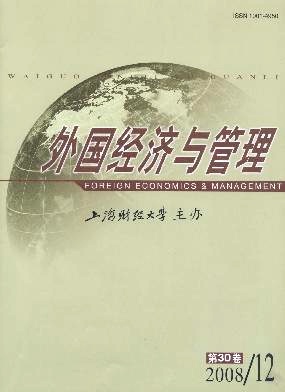西方弹性工作制研究述评及其新进展探析
外国经济与管理 2008 年 第 30 卷第 12 期, 页码:45 - 51
摘要
参考文献
摘要
在经济全球化和企业竞争加剧的形势下,"弹性工作制"以其降低人工成本、增强企业弹性和竞争力的显著优势,开始在西方国家盛行。本文利用62个主要的美国大学文献检索数据库,分别就弹性工作制的动因与优缺点、弹性工作制对企业运营的影响、弹性工作制与绩效的关系、弹性工作制的宏观经济影响四个方面,对近十年来弹性工作制研究的主要内容和最新进展进行了综述,并概括了弹性工作制研究的启示和意义。
[1]Maguire,J S.Leisure and obligation of self-work:An examination of the fitness field[J].Leisure Studies,2008,27(1):59-75.
[2]Sankey,D.It pays to be family friendly:Flexibility is big[N].Montreal Gazette,2008-01-01:B6.
[3]Westerman,A.The relation between corporate training and development expenditures andthe use of temporary employees[J].Ethics and Behavior,2001,11(1):67-86.
[4]Swanberg,J E,James,J B,Werner,M,and McKechnie,S P.Workplace flexibility for hourly lower-wage employees:Astrategic business practice within one national retail firm[J].The Psychologist-Manager Journal,2008,11(1):5-29.
[5]Sankey,D.Flexibility a boon to employees:Canadian firms make big gains on diversity front[N].Calgary Herald,2008-04-05:H1/FRONT.
[6]Pal mer,A D.Workplace flexibility leads to healthier employees[N].Incentives Pub,2008-02-08.
[7]David,J.The unexpected employee and organizational costs of skilled contingent workers[J].Human Resource Planning,2005,28(2):32-40.
[8]Lu,L,Kao,S F,Chang,T T,Wu,HP,and Copper,C L.Work/family demands,workflexibility,work/family conflict andtheir conse-quences at work:Anational probability samplein Tai wan[J].International Journal of Stress Management,2008,15(1):1-21.
[9]Casey,P R,and Grzywacz,J G.Epmloyee health and well-being:The role of flexibility and work-family balance[J].The Psycholo-gist-Manager Journal,2008,11(1):31-47.
[10]Wong,J Y,and Lin,J H.The role of job control and job support in adjusting service employee’s work-to-leisure conflict[J].Tourism Management,2007,28:726-735.
[11]Collishaw,M A,Dyer,L,and Boise,K.The authenticity of positive emotional display:Client responses toleisure service employ-ees[J].Journal of Leisure Research,2008,40(1):23-46.
[12]Belser,A.Study:Fewer monetary benefits,more flexibility at work[N].Pittsburgh Post-Gazette,2008-05-22:C1.
[13]Padavic,I.Laboring under uncertainty:Identity renegotiation among contingent workers[J].Symbolic Interaction,2005,28(1):111-134.
[14]Martin,J E,and Sinclair,R R.Atypology of the part-ti me workforce:Differences onjob attitudes andturnover[J].Journal of Oc-cupational Organizational Psychology,2007,80:301-319.
[15]Kuvaas,B,and Dysvik,A.Invest ment in permanent employees and exchange perceptions among temporary employees[J].Acade-my of Management Proceedings,2007,6:1-6.
[16]Hayashi,Y.In Japan,temporary workers leave lasting mark on economy—companies’moving away from full-ti me employeesblunts momentum[J].The Wall Street Journal,2008,(4):14-20.
[2]Sankey,D.It pays to be family friendly:Flexibility is big[N].Montreal Gazette,2008-01-01:B6.
[3]Westerman,A.The relation between corporate training and development expenditures andthe use of temporary employees[J].Ethics and Behavior,2001,11(1):67-86.
[4]Swanberg,J E,James,J B,Werner,M,and McKechnie,S P.Workplace flexibility for hourly lower-wage employees:Astrategic business practice within one national retail firm[J].The Psychologist-Manager Journal,2008,11(1):5-29.
[5]Sankey,D.Flexibility a boon to employees:Canadian firms make big gains on diversity front[N].Calgary Herald,2008-04-05:H1/FRONT.
[6]Pal mer,A D.Workplace flexibility leads to healthier employees[N].Incentives Pub,2008-02-08.
[7]David,J.The unexpected employee and organizational costs of skilled contingent workers[J].Human Resource Planning,2005,28(2):32-40.
[8]Lu,L,Kao,S F,Chang,T T,Wu,HP,and Copper,C L.Work/family demands,workflexibility,work/family conflict andtheir conse-quences at work:Anational probability samplein Tai wan[J].International Journal of Stress Management,2008,15(1):1-21.
[9]Casey,P R,and Grzywacz,J G.Epmloyee health and well-being:The role of flexibility and work-family balance[J].The Psycholo-gist-Manager Journal,2008,11(1):31-47.
[10]Wong,J Y,and Lin,J H.The role of job control and job support in adjusting service employee’s work-to-leisure conflict[J].Tourism Management,2007,28:726-735.
[11]Collishaw,M A,Dyer,L,and Boise,K.The authenticity of positive emotional display:Client responses toleisure service employ-ees[J].Journal of Leisure Research,2008,40(1):23-46.
[12]Belser,A.Study:Fewer monetary benefits,more flexibility at work[N].Pittsburgh Post-Gazette,2008-05-22:C1.
[13]Padavic,I.Laboring under uncertainty:Identity renegotiation among contingent workers[J].Symbolic Interaction,2005,28(1):111-134.
[14]Martin,J E,and Sinclair,R R.Atypology of the part-ti me workforce:Differences onjob attitudes andturnover[J].Journal of Oc-cupational Organizational Psychology,2007,80:301-319.
[15]Kuvaas,B,and Dysvik,A.Invest ment in permanent employees and exchange perceptions among temporary employees[J].Acade-my of Management Proceedings,2007,6:1-6.
[16]Hayashi,Y.In Japan,temporary workers leave lasting mark on economy—companies’moving away from full-ti me employeesblunts momentum[J].The Wall Street Journal,2008,(4):14-20.
引用本文
魏翔. 西方弹性工作制研究述评及其新进展探析[J]. 外国经济与管理, 2008, 30(12): 45–51.
导出参考文献,格式为:
上一篇:国外关系营销导向研究前沿探析





 8566
8566  317
317

